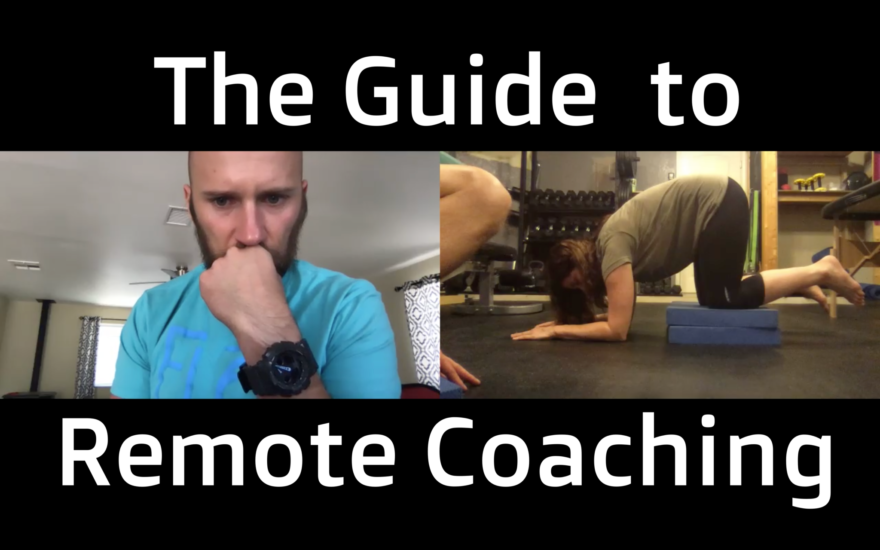Table of Contents
How to coach movement when you can’t in-person
Movement Debrief Episode 113 is in the books. Below is a copy of the video for your viewing pleasure, and audio if you can’t stand looking at me. You’ll also get modified transcripts for this one. That’s how much I care!
Here is the setlist:
- Why should you consider remote consultations
- What are realistic expectations regarding a remote consultation business?
- What are the challenges of a remote consultation business?
- What does the remote consultation process look like?
- How do I screen for red flags?
- What remote assessments do I use?
- How does once coach someone remotely?
- How do I set up remote coaching classes with multiple people?
- What substitutes do I use when external load is not available?
If you want to watch these live, add me on Instagram. Enjoy!
and the audio version:

 t
tShow notes
Check out Human Matrix promo video below:
Below are some testimonials for the class:
Want to sign up? Click on the following locations below:
May 23rd-24th, 2020, Dickinson College in Carlisle PA (Early bird ends April 26th at 11:55pm!) [Approved for 14 Category A CEUs for athletic trainers]
June 6th-7th, 2020, Minneapolis, MN (Early bird ends May 3rd at 11:55pm!)
August 1st-2nd, Boston, MA (Early bird ends July 5th at 11:55pm!)
September 12th-13th, Montreal, Canada (Early bird ends August 16th at 11:55pm!) [6 CEUs approved for Athletic Therapists by CATA!]
October 3rd-4th, Ann Arbor, MI (Early bird ends September 6th at 11:55pm!)
November 7th-8th, Charlotte, NC (Early bird ends October 11th at 11:55pm!)
November 21st-22nd, San Diego, CA (Early bird ends October 25th at 11:55pm!)
Madison, NJ (POSTPONED DUE TO COVID-19)
Atlanta, GA (POSTPONED DUE TO COVID-19)
Or check out this little teaser for Human Matrix home study. Best part is if you attend the live course you’ll get this bad boy for free! (Release date not known yet 🙁
Here is a signup for my newsletter to get nearly 5 hours and 50 pages of content, access to my free breathing and body mechanics course, a free acute:chronic workload calculator, basketball conditioning program, podcasts, and weekend learning goodies:
[yikes-mailchimp form=”1″ submit=”Get learning goodies and more”]
How to start a remote consultation business
A remote consultation can be a very lucrative side hustle, or even full-time hustle.
I started doing a bulk of my remote consultations in 2017. Over the course of a few years, I was able to make this a six-figure business. So I encourage you, if you can please start.
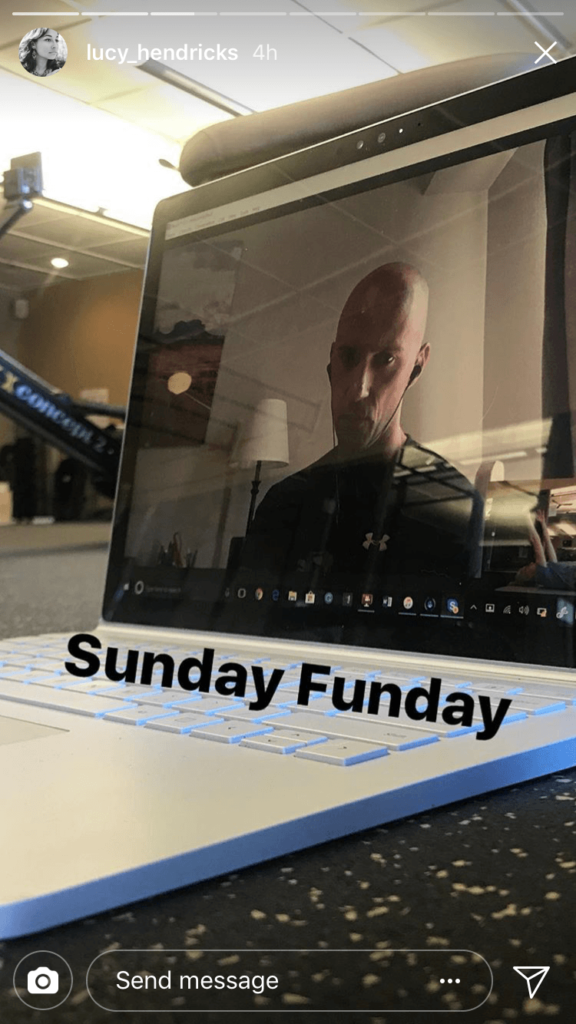
That being said, it’s not something that’s going to fix your financial woes right now. Tough times are had by all right now, myself included. But remote coaching can help maintain your current client base during this quarantine.
You also must realize that remote coaching has a bit of a learning curve to it.
But I’m going to help you problem-solve through and save you time if it’s a route you wish to pursue.
How do you get started? First off, you need to figure out a way to advertise to people.
If you are someone who predominantly has an in-person business, advertise this service to your current clients. Offering remote sessions could be an opportunity to show your clients you care about their health and don’t wish to spread the coronavirus.
Expanding beyond your client base means you must be prepared to do a lot of free stuff for a while; producing content towards your market and offering free sessions until you get better adept at remote coaching.
When I was first starting out, I couldn’t tell you the number of times that I would either give someone a free session due to my coaching struggles through this medium or extending a one-hour session to two without charging extra. There’s a lot of trial and error with remote coaching, but understanding clients you currently have maybe the best way to practice.
Remote consultation business benefits
It’s another income stream that protects you when your current income stream falters. For example, a lot of us right now, myself included, might have in-person businesses that are struggling. Having multiple income streams can better protect you when crap hits the fan.

There’s a great book called Antifragile, which discusses Black Swan events. These are events that shake the foundations of what we know in our world and can destroy fragile processes. Those who are antifragile can grow from these events. Having multiple income streams increases antifragility and survival during tough times.
On the flip side, I also would encourage people who are only doing online stuff to look into doing in-person business as well. Perhaps we get hit with a cyber terrorist attack that wipes out internet access. You’d be out of luck.
Diversity of revenue streams is really the key, and remote coaching can be a great one.
How to increase client buy-in for remote consultations
Producing results is probably the best way to get buy-in. If you already have current clientele and you’re getting them good results, let them know that remote coaching can maintain those improvements. You could also reduce the pressure on the client by only charging them if you can get a result.
I have screening processes and know quickly within the session whether or not I’m going to be a good fit for this person. If I don’t think I’m going to be a good fit or have a low chance of success, I will either take them on pro bono, or refer them to where I feel they would be better served.
The remote coaching process
Make sure you set up your system so you can screen out people that are not appropriate for remote consultations and is easy to use.
I have a questionnaire that screens out clients who have a low success probability or possible red flags. I am all about minimizing expenses with this, so I use a Google Form with the Form Publisher plugin. I’ll glance through the form before I work with the person, and if I see any major red flags, I’ll advise them on what route they should go instead of me.
I use Calendly for scheduling, which has a ton of flexibility. You can limit the number of clients in a day, pick appointment durations, and it’s easy to use.
I also have a waiver that I have people sign, letting them know that this is not a substitute for medical care. I like Dochub because it’s cheap and allows templates.
The ideal remote coaching environment
The next piece is making sure the physical environment promotes a good coaching session.
When we’re discussing the setup, the device your client uses and room lighting can make or break the session.
First, let’s go into the device. You’ll want to have an adjustable camera so viewing angles can easily change. It’s not a good idea to have someone hang onto their phone and try to prop it up by various means. Ideally, your client will either use a laptop with a webcam or a tablet/phone with a stand.
A laptop is arguably the best because the screen is large, and the camera angle can easily change. You’ll want to make sure that their webcam is on the top of the screen, not the bottom. Otherwise, you’ll be evaluating their keyboard.

To maximize your view, you’ll want the client to be in a well-lit room and wear bright clothing. A dark house with dark clothes will limit how well you can see your clients move, and impair your coaching capabilities. They’ll blend into the background. I like James Bond as well as the next person, but not for a remote consultation. To maximize lighting, have clients close windows and turn up their lights. This isn’t the time for Teddy Pendergrass!
Ask the client to have the required equipment ready ahead of time. With the initial email I send, I give clients a list of equipment I’d like them to have. I don’t make clients buy equipment unless I have to. Simple household items work just fine, such as a toilet paper roll (maybe not during the quarantine), small ball, paper towel roll, a book to elevate heels, etc. Simple things that can get profound results.
The best call software by far is Zoom. I’ve tried all of the meeting apps out there, and the call quality on Zoom is far superior. You can also share your screen and have a “whiteboard” to draw stuff for client education. If you have an Ipad with an Apple pencil, you can do amazing things. You can also lock the room to keep the sessions private.
If you are sticking to one-on-one sessions, Zoom is free. You can also do group sessions on Zoom free if the classes are kept under 40 minutes. Anything longer and you are looking at $14.99 per month, which is still pretty reasonable. I might sound like a Zoom salesperson, but I’m not (though if they want to pay me, by all means!) It’s just that good.
How to assess movement remotely
Let’s talk about the session itself. In order to choose useful exercises for your clients, you need to assess them.
Most special tests cannot be performed remotely, but I personally do not find them all that useful. A thorough subjective and good intake form can sound the alarm on any red flags; special tests are there to just build your case.
If you have any hesitancy about seeing someone based on their intake and subjective what they’re saying in their intake forms, either clarify beforehand or refer out the appropriate practitioner. Do no harm first and foremost.

Now onto assessing movement. This will be broken down into two components. First, I’ll find a meaningful movement for the client. If you find an activity that the client struggles with and make it better with your interventions, you’ve immediately increased buy-in.
Aside from finding an important movement for the client, my movement model focuses on assessing certain strategies clients use. I break movement strategies down into two categories: inhalation-bias or exhalation-bias. My testing aims to appreciate these strategies in various movement contexts.
Make sure to get two angles of many of these tests so you can get a better picture of the client’s movement capabilities. To simplify things for the client, demo these two angles before asking them to do the movement.
I start with standing tests to get a gross evaluation of these mechanics. Here is my test cluster:
Toe Touch

A toe touch assesses exhalation mechanics because the sacrum must nutate for you to touch your toes. I coach this movement with feet hip-width apart and knees locked. Can’t touch your toes? You likely have an exhalation restriction. If someone easily touches their toes or palms the floor, they are likely too exhaled.
Toe Touch to Squat

Next, I look at a toe touch to squat to assess inhalation mechanics. The goal is the person to squat all the way down without rotating through the legs. The starting position is the same as the toe touch. If the squat isn’t full, you know you need to focus on driving inhalation mechanics.
Shoulder Extension

To assess pump handle mechanics, I use shoulder extension. I’ll first look at a posterior view, and cue the client to keep the arm in close to the body. Move the arm as far back as you can. Then, ask the client to spin to the side so you can get the angle. You are looking for 65 degrees without arm abduction as normal. Limitations here would point you towards driving air into the front of the chest.
Knee to Chest
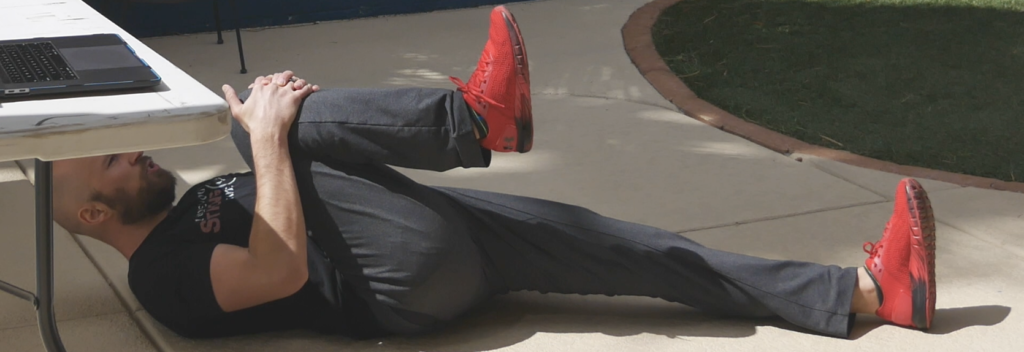
These next tests dive deeper into someone’s movement strategies. Knee-to-chest is one of my big lower body tests. The goal is to compress the knee to the chest without falling into hip abduction. The down leg should be maintained on the ground without flexing up or externally rotating. On the flexed side, you assess inhalation mechanics, the extended side would be exhalation.
Active Straight Leg Raise
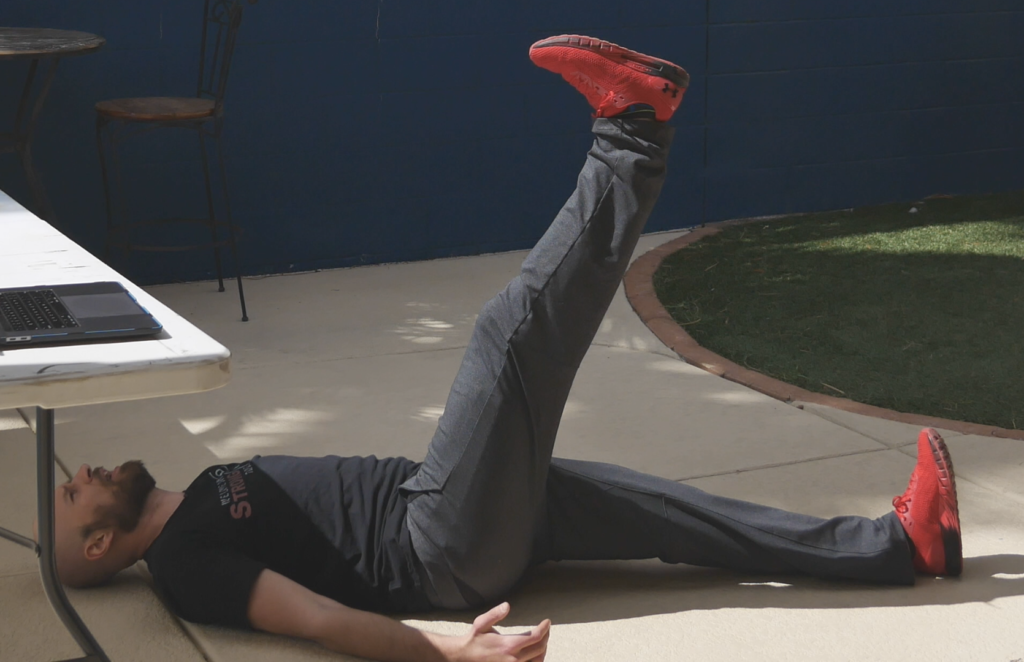
The active straight leg raise is another great test with more of an exhalation-bias, with a goal of 90 degrees. There are two components that make this test more exhalation-biased. First, knee extension drives femoral internal rotation and approaching 90-100 degrees of hip flexion biases hip internal rotation as well. Hip internal rotation is a component of exhalation mechanics.
Shoulder External Rotation
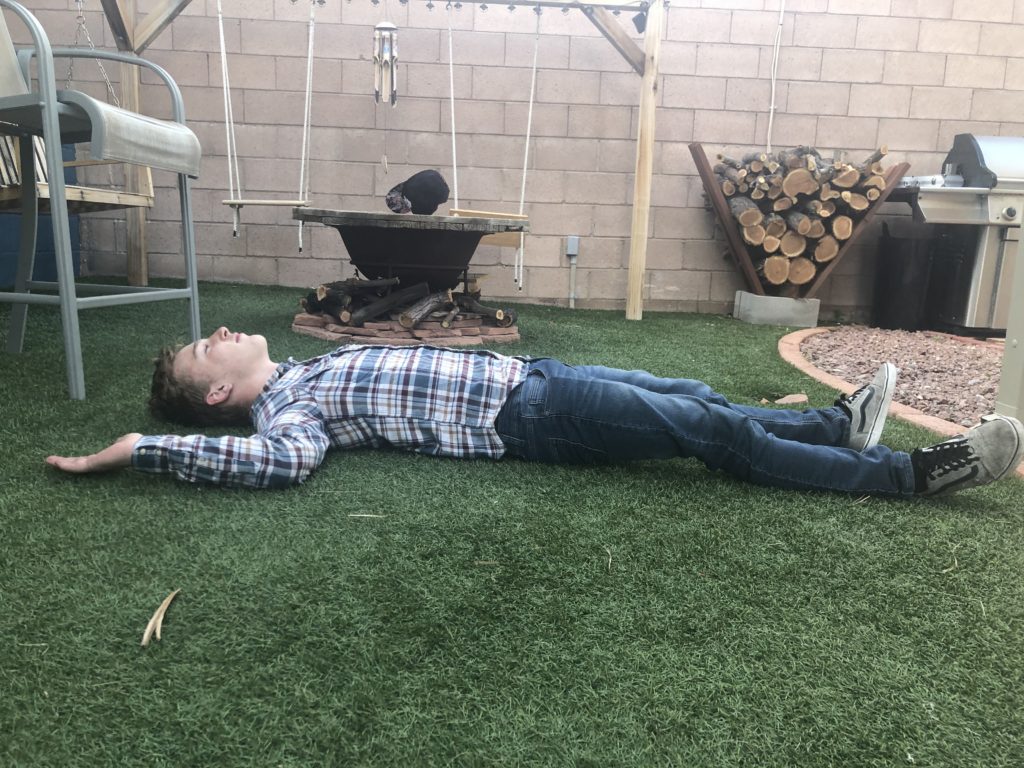
I have two tests that look at posterior thorax expansion. First, I look at shoulder external rotation with 90 degrees of abduction. Normal would be lying the arm down with around 30 degrees of wrist extension. If the forearm goes flat, that’s likely because the person has excessive shoulder external rotation. There should actually be slight restrictions into external rotation at this range, as the test position is in slight horizontal abduction.
Shoulder Flexion

Second, I’ll look at shoulder flexion. The goal is the arm being in-line with the ear. The elbow is locked in and palm is facing up. You’ll also want to place one hand on the ribcage to feel if it raises up as shoulder flexion commences. If the ribcage pops up or the elbow flares out, you would call the test at that range.
Infrasternal Angle

The last thing I’ll look at is the infrasternal angle (ISA). I’ll have someone place the laptop on their lap or hold the phone

in front of their stomach. They can trace the ribcage, or breathe in and out so I can see the movement. Note the ribcage shape and dynamic capability.
How to coach someone remotely
Remote coaching is a completely different skillset from in-person coaching. Many of the coaching techniques at our disposal are eliminated when all you have is a screen. You must be good with your words and ability to demonstrate exercises. If you can’t move, you will struggle to coach in this environment.
Your exercise selection matters. You might use a bunch of fancy exercises, but you’ll want to scrap them for the remote session. You won’t be as good at coaching remotely as you are in-person. When you are climbing the remote coaching learning curve, you want to use simple moves to increase your success rate. Keep it simple.
Make sure to demonstrate the move first, then break down each component as the client performs the action. Go slow and take your time with coaching the moves. Use multiple sets to get the exercise nailed down. You want to slow cook the movement brisket so you get it done just right!
If the client is compensating as they perform the activity, the good-bad-good demonstration-style works great. Show them how you want the move to look, show them what they are doing, and then show them the right way once more.
Just like with the assessment, try to get multiple views of the activity. I start with a side view with almost every exercise. This angle best appraises the client’s ability to stack the ribcage and pelvis. Stacking involves creating a posterior pelvic tilt and a full exhalation. If your client cannot stack, they will not pressurize the ventral cavity effectively. Once the side view looks good, then you can progress to a different angle.
Coaching group classes remotely
If you are considering doing group classes remotely, I would start with smaller groups. It’s challenging enough coaching one person remotely, let alone 10. As you improve your coaching skills, then you can increase the number of people in your class.
How many sessions to remote coach in a day
You’ll also want to be mindful of the number of sessions you do in a day. Remote coaching can be exhausting because you are staring at a screen for hours on end. Take your current number of clients seen in a day and cut it in half. That way you keep the quality high, minimize your fatigue, and not become too sedentary.
How to remote coach people who are excessively restricted in their movement
For individuals for are so limited that they need an external load to change their movement, you can see improvements with minimal equipment. Give these clients the most challenging bodyweight exercises you can possibly do.
For example, suppose you have someone with a wide infrasternal angle who needs to stack. Based on this article, putting people in the sideline position promotes reduced lateral ribcage dimensions and an increased anteroposterior shape. Activities like side planks and Copenhagen adductor exercises are really useful for these clients.
Below is an example of a side plank activity I like:
And here is a great copenhagen adductor exercise variation.
A narrow infrasternal angle person might consider headstand variations or various pushup progressions. Anything that uses their heaviness against them can make positive changes.
Below is a great headstand variation to try.
You can also mess with various pushup variations.
Don’t be afraid to MacGyver stuff at home to help people with doing these activities. You could have them load up various household items for resistance. Lift garbage cans, heavy bags, anything heavy.
If your client is willing to spend some money, bands can be a great way to add resistance.
Sum Up
- Remote consulting can be a useful adjunct income stream, but consider it like starting a new business. Focus on your current clients first.
- Get buy-in by offering clients to pay only if it works, as well as classic advertising measures.
- Screening questionnaires and online documentation should be in place to determine which clients will be appropriate for remote consultations and to make it easy for the client.
- Make sure clients uses a laptop or adjustable stand during their session. Request that they are in a well-lit room and wear bright clothing.
- find proxy assessments to measure what is important to you. Always use two views to assessment
- Coach exercises by using two views, demoing the exercise, and verbal cueing.
- Keep the number of clients you see remotely fewer than you do in-person to reduce fatigue and being sedentary. Start with one-on-one and progress to group as you improve your coaching skills
- Use challenging bodyweight moves or heavy household items for those with strong compensatory patterns

